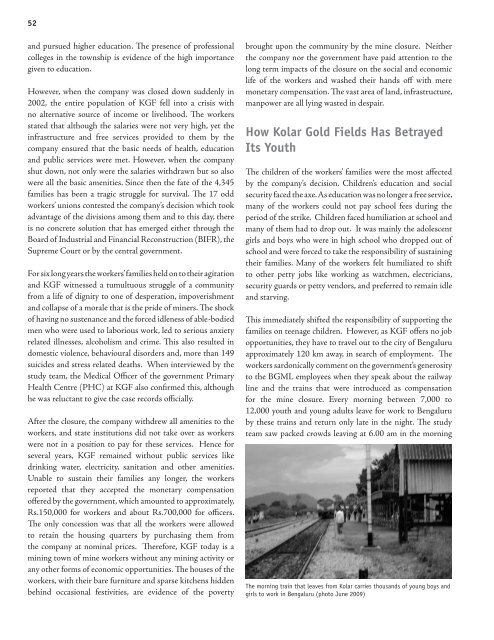Children - Terre des Hommes
Children - Terre des Hommes
Children - Terre des Hommes
You also want an ePaper? Increase the reach of your titles
YUMPU automatically turns print PDFs into web optimized ePapers that Google loves.
52<br />
and pursued higher education. The presence of professional<br />
colleges in the township is evidence of the high importance<br />
given to education.<br />
However, when the company was closed down suddenly in<br />
2002, the entire population of KGF fell into a crisis with<br />
no alternative source of income or livelihood. The workers<br />
stated that although the salaries were not very high, yet the<br />
infrastructure and free services provided to them by the<br />
company ensured that the basic needs of health, education<br />
and public services were met. However, when the company<br />
shut down, not only were the salaries withdrawn but so also<br />
were all the basic amenities. Since then the fate of the 4,345<br />
families has been a tragic struggle for survival. The 17 odd<br />
workers’ unions contested the company’s decision which took<br />
advantage of the divisions among them and to this day, there<br />
is no concrete solution that has emerged either through the<br />
Board of Industrial and Financial Reconstruction (BIFR), the<br />
Supreme Court or by the central government.<br />
For six long years the workers’ families held on to their agitation<br />
and KGF witnessed a tumultuous struggle of a community<br />
from a life of dignity to one of <strong>des</strong>peration, impoverishment<br />
and collapse of a morale that is the pride of miners. The shock<br />
of having no sustenance and the forced idleness of able-bodied<br />
men who were used to laborious work, led to serious anxiety<br />
related illnesses, alcoholism and crime. This also resulted in<br />
domestic violence, behavioural disorders and, more than 149<br />
suici<strong>des</strong> and stress related deaths. When interviewed by the<br />
study team, the Medical Officer of the government Primary<br />
Health Centre (PHC) at KGF also confirmed this, although<br />
he was reluctant to give the case records officially.<br />
After the closure, the company withdrew all amenities to the<br />
workers, and state institutions did not take over as workers<br />
were not in a position to pay for these services. Hence for<br />
several years, KGF remained without public services like<br />
drinking water, electricity, sanitation and other amenities.<br />
Unable to sustain their families any longer, the workers<br />
reported that they accepted the monetary compensation<br />
offered by the government, which amounted to approximately,<br />
Rs.150,000 for workers and about Rs.700,000 for officers.<br />
The only concession was that all the workers were allowed<br />
to retain the housing quarters by purchasing them from<br />
the company at nominal prices. Therefore, KGF today is a<br />
mining town of mine workers without any mining activity or<br />
any other forms of economic opportunities. The houses of the<br />
workers, with their bare furniture and sparse kitchens hidden<br />
behind occasional festivities, are evidence of the poverty<br />
brought upon the community by the mine closure. Neither<br />
the company nor the government have paid attention to the<br />
long term impacts of the closure on the social and economic<br />
life of the workers and washed their hands off with mere<br />
monetary compensation. The vast area of land, infrastructure,<br />
manpower are all lying wasted in <strong>des</strong>pair.<br />
How Kolar Gold Fields Has Betrayed<br />
Its Youth<br />
The children of the workers’ families were the most affected<br />
by the company’s decision. <strong>Children</strong>’s education and social<br />
security faced the axe. As education was no longer a free service,<br />
many of the workers could not pay school fees during the<br />
period of the strike. <strong>Children</strong> faced humiliation at school and<br />
many of them had to drop out. It was mainly the adolescent<br />
girls and boys who were in high school who dropped out of<br />
school and were forced to take the responsibility of sustaining<br />
their families. Many of the workers felt humiliated to shift<br />
to other petty jobs like working as watchmen, electricians,<br />
security guards or petty vendors, and preferred to remain idle<br />
and starving.<br />
This immediately shifted the responsibility of supporting the<br />
families on teenage children. However, as KGF offers no job<br />
opportunities, they have to travel out to the city of Bengaluru<br />
approximately 120 km away, in search of employment. The<br />
workers sardonically comment on the government’s generosity<br />
to the BGML employees when they speak about the railway<br />
line and the trains that were introduced as compensation<br />
for the mine closure. Every morning between 7,000 to<br />
12,000 youth and young adults leave for work to Bengaluru<br />
by these trains and return only late in the night. The study<br />
team saw packed crowds leaving at 6.00 am in the morning<br />
The morning train that leaves from Kolar carries thousands of young boys and<br />
girls to work in Bengaluru (photo June 2009)






